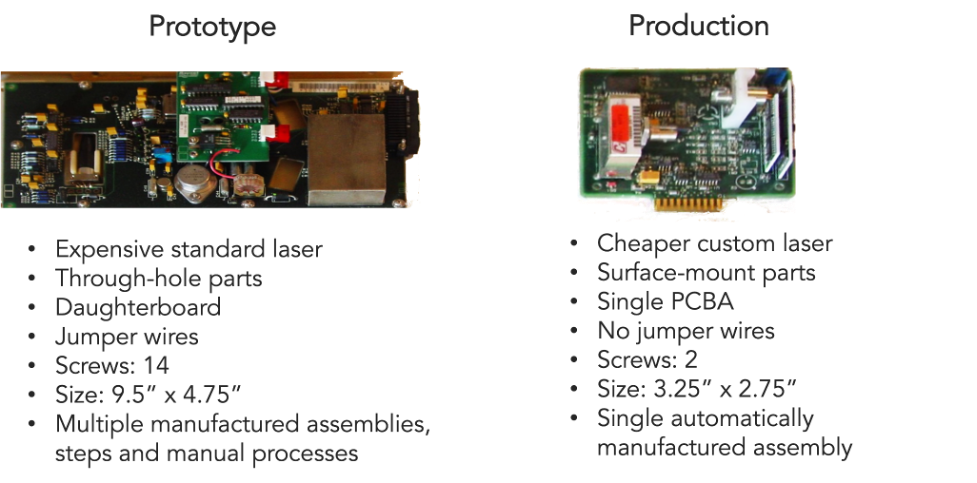
6. DESIGN & PLANNING – Part 3: Design for Excellence (DfX)
Mapping good ideas to product development is best done in the concurrent engineering framework, a collaborative approach to new product introduction. Using the MVP and the product roadmap, you are now ready to move into balancing design concepts with business concerns like costs.

Design for Assembly
Design for Assembly (DFA) is a design approach that aims to optimize the manufacturing process and minimize the complexity and cost of assembling a product. It involves identifying and focusing on the key factors that affect the ease and efficiency of assembly, such as the number of components, the fit and tolerances of the parts, and the order in which the parts are assembled.
One of the best ways for you to design for assembly is to setup a cross-functional team consisting of mechanical design and manufacturing engineers. Both disciplines bring a perspective about best practices and can recommend several options for each assembly. Collectively, your team can discuss the pros-cons of each option and arrive at the best DFA solution.
Design for Cost
Similar to DFA, a setting up a cross-functional team will help you optimize for cost. But, since Design for Cost (DFC) is such a broad topic, adding the following experts to your bench will help.
- Purchasing/procurement
- Supply chain
- Process engineering – eliminate unnecessary steps
- Fixture/tooling engineers
- Test engineers
Design for Manufacturing
Design for Manufacturing (DFM) is a design approach that optimizes the manufacturing process and minimizes the complexity and cost of producing a product. It involves identifying and focusing on the key factors that affect the ease and efficiency of manufacturing, such as the materials used, the number of components, the fit and tolerances of the parts, and the manufacturing processes and equipment required.
DFM is similar to DFA, but broader in scope to include the end-to-end manufacturing process. The image below shows how you can save a lot of money when it comes to volume manufacturing (production) by reducing the size, reducing the amount of assembly and test required, and moving to mass-produced plastic enclosures (where you can). The yellow prototype case on the left is bespoke, whereas the case on the right is a more cost-effective product version.


Design for Test
Design for Test (DFT) is an important but often overlooked step in the early part of the development process. To improve DFT, it’s helpful to work with design, manufacturing, and quality engineers. While your design engineers understand what needs be tested, other parts of the organization can ask more specific questions like:
- How many test points are built into the pc-board?
- Can we automate parts of the test process?
- Do we need to test sub-assemblies or just the final assembly?
- What is the pass/fail criteria for each item?
Design for Service (DFS) and Supply Chain (DFSC)
Finally, you should think about how to design for service and supply chain.
Service
- Optimize the maintenance and repair process
- Minimize the time and cost required to keep a product operating at its best
- Identify key factors that affect the ease and efficiency of servicing a product
- Access to parts
- Use of standard components
- Availability of documentation and tools
Supply Chain
- Optimize the flow of materials
- Minimize the time and cost required to produce and deliver a product
Manufacturing Plan
Choosing the right manufacturing strategy is critically important to save both time and money long term. Once your design is complete and you have a bill of materials (BOM), it’s time to start thinking about manufacturing strategy and plans. Here is a list of considerations:
- Production volume
- Manufacturing location
- Product complexity
- Payment terms
- Management alignment
- Quality
- Cost
- Delivery
- Engineering-process expertise
- Outsource to a contract manufacturer (CM)
- Right sizing, for example, is the (CM) the right fit for your business size and volume?
- Proper internal resources to support
- Regular CM reviews (quarterly)
- Regulatory compliance (ISO, FDA, ITAR, etc.
- Vertically integrated (in-house) manufacturing
- Transition plan from in-house to domestic or offshore CM
- Last mile manufacturing, for example, manufacture subassemblies in one location with final assembly in another
Successful product teams also need to think through the context and environment the CM operates in.
- English language fluency within the workforce
- Political stability in the region
- Trade barriers, taxes, laws, and regulations
- Specifically for electronics manufacturing
- Electricity and water supply
- Road and trucking networks
- Plastics, metal, cables, packaging nearby or local
- Year of experience operating in each location
- Less companies versus foreign owned companies
- Low probability of being susceptible to future tariffs
- Less susceptibility of natural disasters, tsunami, etc
- Good road networks, proximity to ports
- Excellent IP and legal protection
- Direct flights, or easy connections
Target Costs for Volume Production
Finally, understanding your target costs for volume production is the foundation of your profit margins.
- Manufacturing Cost
- Parts (BOM)
- Labor (estimate)
- Manufacturing Overhead (markup)
- Total Cost (markup)
- LifeCycle Cost (markup)
While lowering direct costs is advantageous, it’s equally important to keep in mind the risk associated working with low-cost suppliers that provide poor service and the additional cost of product returns and repairs.
Essentially, DfX is about thinking ahead and understanding the tradeoffs inherent in manufacturing.



